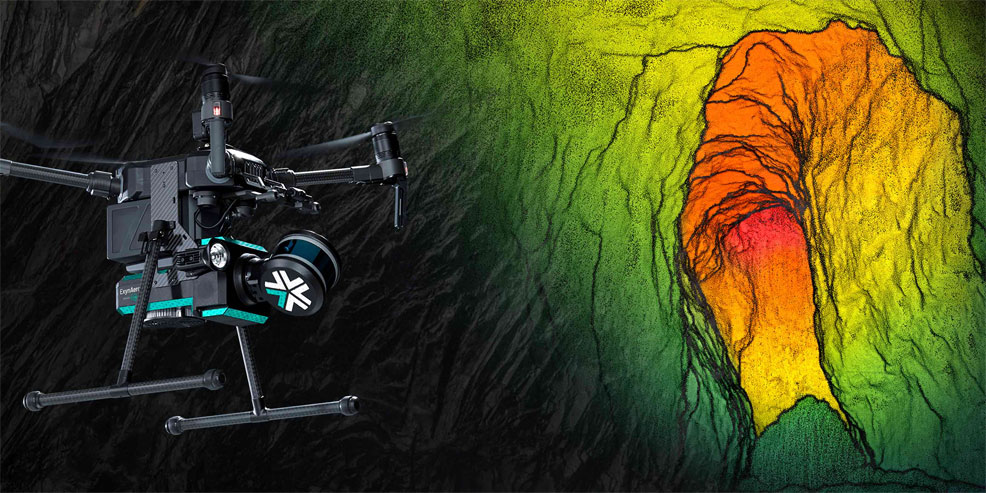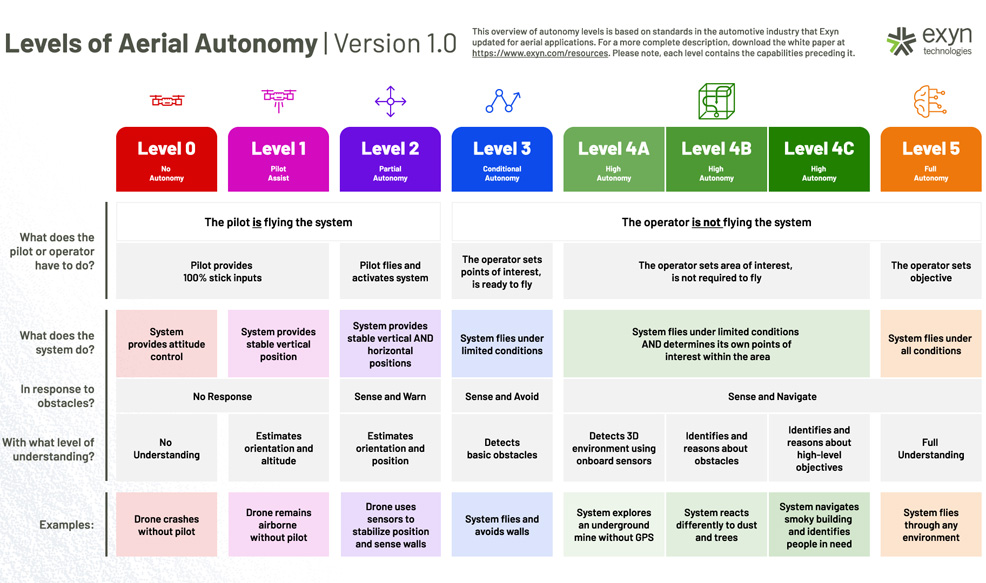
1st June 2021 New drone is first to reach Level 4 autonomy Exyn Technologies, a pioneer in aerial robot systems, has announced the highest documented level of aerial autonomy.
Exyn's drones are now capable of Level 4A autonomy – meaning they are immune to GPS signal loss, with all spatial and mapping computations able to be performed onboard, the company said. This enables free-flight exploration of complex spaces, with full determination of flight paths at over 2 m/s flight speeds (double the previous standard), and higher quality data collection in larger volumes. Under ideal conditions, Exyn's drones can cover 16 million cubic metres in a single flight, the equivalent of nine football stadiums. Earlier industry standards for aerial autonomy have used waypoints and multiple flights to obtain adequate intelligence. By contrast, Exyn's new drones are completely self-reliant for open-ended exploration and do not require any human interaction during flight. This is a major step up from the lower Level 3 standard in which a human operator is required to be present and available to take control of the system at any time. "The ability for UAVs to fly beyond the operator's visual line of sight has been a milestone in achieving true pilotless autonomy," said Nader Elm, CEO of Exyn. "Most players in this space have achieved Level 2, or perhaps Level 3 autonomy at best, which in the best cases necessitates persistent communications and a fallback-ready human operator to intervene or direct the system to complete the mission. "Our systems are not only the most sophisticated available commercially worldwide, but the unique capabilities we possess are fundamentally necessary for safe and successful operation in the most challenging of environments. This has been the missing link to maximising the success of critical applications – such as industrial inspections, search and rescue missions and Intelligence, Surveillance and Reconnaissance (ISR) for government operations."
In simple terms, comparing previous autonomy standards with that of Exyn is like the difference between self-navigating a single, defined road versus uncharted terrain in unknown and unmapped territory. Unlike a car, however, a drone must be able to manoeuvre within three dimensions and pack all its intelligence and sensors onto a fraction of the total body size with severe weight restrictions. "People have been talking about Level 4 Autonomy in driverless cars for some time, but having that same degree of intelligence condensed onboard a self-sufficient UAV is an entirely different engineering challenge in and of itself," said Jason Derenick, CTO at Exyn Technologies. "Achieving Level 5 is the holy grail of autonomous systems – this is when the drone can demonstrate 100% control in an unbounded environment, without any input from a human operator whatsoever. While I don't believe we will witness this in my lifetime, I do believe we will push the limits of what's possible with advanced Level 4. We are already working on attaining Level 4B autonomy with swarms, or collaborative multi-robot systems." "There's things that we want to do to make it faster, make it higher resolution, make it more accurate," said Elm, in an interview with Forbes. "But the other thing we were kind of contemplating is basically the ability to have multiple robots collaborate with each other so you can scale the problem – both in terms of scale and scope. So you can have multiple identical robots on a mission, so you can actually now cover a larger area, but also have specialised robots that might be different. So, heterogeneous swarms so they can actually now have specialised tasks and collaborate with each other on a mission." "Think of building a three-dimensional map and then draping on top of it RGB information from the camera, so now you've got a photorealistic 3D representation of the space," Elm told TechCrunch. "If we're carrying heat and humidity sensors, getting radiological reading, getting gas readings, checking the ventilation, etc. That's going to be a very rich dataset that currently underground mining doesn't have." "Exyn's latest technology demonstration pushes the boundary of what can be done with autonomous flying systems in situations where GPS is not available," said Camillo Taylor, Professor of Computer and Information Science at the University of Pennsylvania. "Getting aerial systems to fly reliably in cluttered environments is extremely difficult and manual piloting in underground settings is often impossible. Having a solution that allows human operators to task these systems at a very high level, without needing piloting expertise, opens up a number of applications in autonomous inspection of mines and other critical infrastructure." Exyn has successfully commercialised industrial-grade drone autonomy with major customers in mining, construction and logistics, and will roll out its Level 4 autonomous capabilities over the next few months.
Comments »
If you enjoyed this article, please consider sharing it:
|








